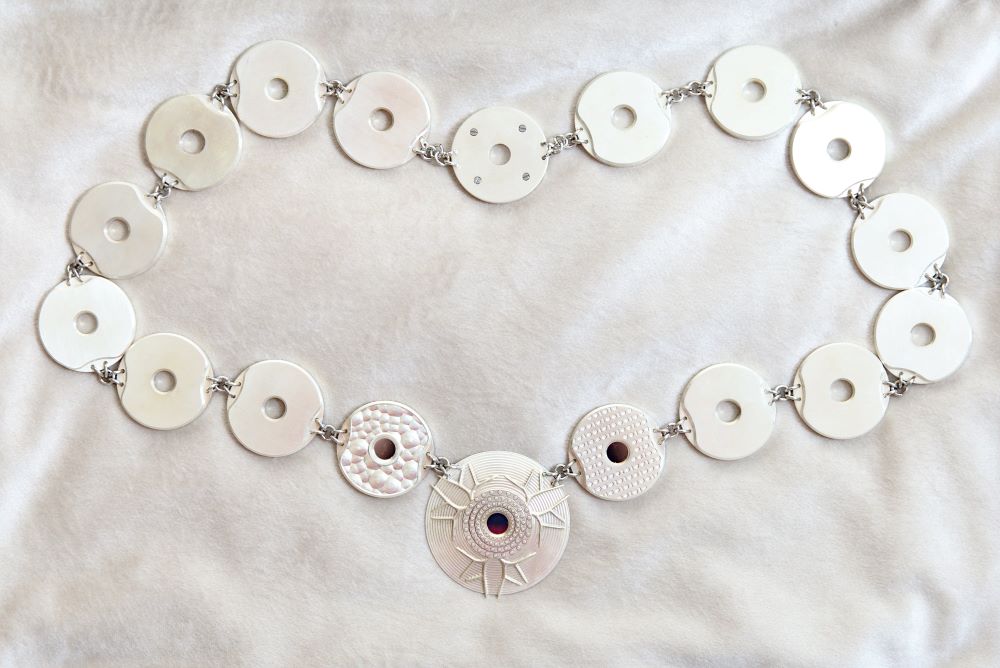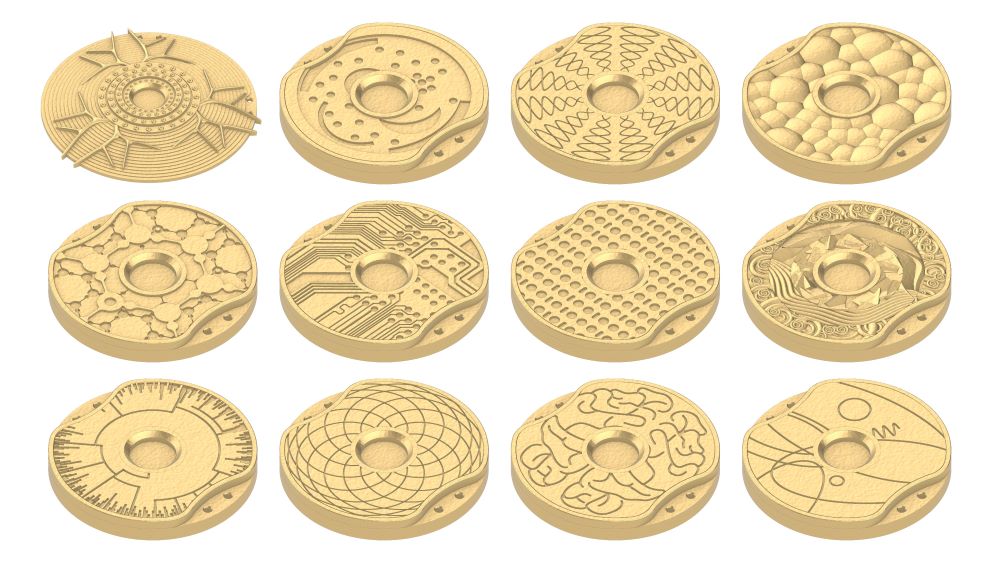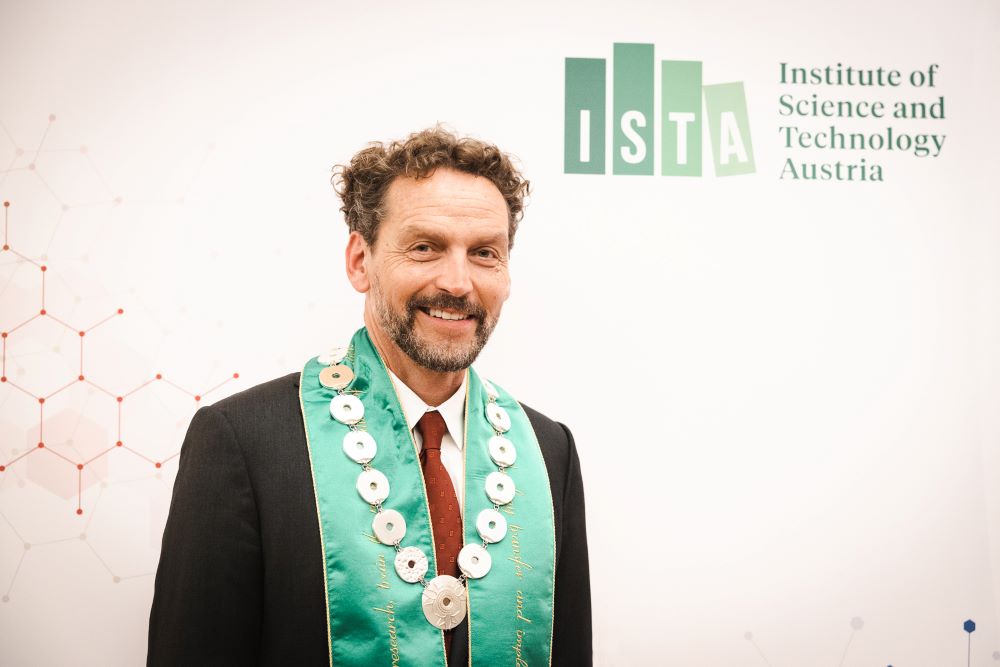May 31, 2023
How to Create a New Institutional Tradition
A new presidential heirloom symbolizes research and history at ISTA
Traditions symbolize an institution’s history and values. A relatively young institution like the Institute of Science and Technology Austria (ISTA) has the chance to create new traditions on its own. Based on the Institute’s research fields and values and in collaboration with Austrian artist and designer Andreas Palfinger, ISTA created a new presidential chain as an heirloom to be handed down from generation to generation.

How do you create a new institutional tradition that lasts? A team at the Institute of Science and Technology Austria (ISTA) had to answer this question for the inauguration ceremony of Martin Hetzer, its second president, which took place this April. Time-honored universities are steeped in traditions, displaying their historic insignias, dramatic robes, or even an intricate scepter at festivities like this.
But what was a relatively young institution like ISTA to do for the first handover of its presidency? A dedicated team surrounding Mia Meus, science exhibition curator at ISTA, and Austrian designer and artist Andreas Palfinger took on this challenge.
Imbuing with Significance
The inauguration of Martin Hetzer was a first in ISTA’s history. Its founding president, Tom Henzinger, had led the Institute since its inception in 2009 until Hetzer took over at the start of 2023. The ceremony and its insignias had to honor Henzinger’s dedication and achievements, as well as symbolize the handing over of the office of the president. This occasion needed something that highlights the multidisciplinary research approach at ISTA, its core values, and the people behind it.
“We wanted to create an heirloom object to be handed down from president to president,” Meus explains. “It should combine the sciences with the arts and be set apart from the very traditional insignia seen at other institutions by actively accumulating the history of the institute over time.” A daunting task, but Meus just knew the right person to contact.
Andreas Palfinger is an Austrian artist now based in New York focusing on interdisciplinary work within the frameworks of virtual scenography, organic-parametric geometry, and functional fictions. He was immediately excited about this project, saying, “What was intriguing while working on this piece were the questions it opened up—about ways of establishing systems that will last longer than every single person involved today.”
Designing a Symbol
Together with Meus, Hetzer, and several ISTA staff members, Palfinger came up with a design for a presidential chain that represents both ISTA’s presidents, their work, and the Institute itself.
As a nod to the multidisciplinary research culture at ISTA, the chain features a combination of organic and technology-inspired elements. Its centerpiece is a framed silicon disc representing the Institute itself, with ISTA’s founding principles written on it in golden micrometer-scale letters alongside a silhouette of the historic Central Building. Ornaments surround the center, but instead of precious gemstones, they are screw-like shapes expressing the engineering side of research and its wider technological impact.
Organic shapes alluding to self-repeating fractals and reaching out from the center of the disc represent the wide range of scales research is done at ISTA—from atoms and molecules to cells and ants and even up to interstellar space. The concentric circles they cross symbolize solar revolutions, growth of tree rings, and the periodical recurrence of cycles in all of science.

The pieces that form the chain itself—called elements—play an important role in it becoming an evolving artifact. Onto each element’s center, ISTA’s Nanofabrication Facility will write on a microscopic scale the name and term duration of the Institute’s presidents. As every president is also a leader of a research group at ISTA, the design of their chain elements also represents their field of research. There are eleven major research areas at ISTA, therefore a design was created for each one. Currently, Henzinger’s work on concurrent and embedded systems in computer science and Hetzer’s research in protein homeostasis and aging in cell biology form the first two dedicated chain links. In the decades to come, the rest of the links will receive their own designs, each one for a president of ISTA.
Additionally, the team around Meus created two fabric stoles in ISTA-green embroidered with ISTA’s mission statement. These were worn at the inauguration ceremony by the leaving and the new president. Meus adds, “Traditions need stories behind them and we are telling one with this new heirloom we created. It combines the foundations the Institute is built on with the passing on of the presidency over the years.”
Writing in Nanometers
Once the designs were ready, Meus and her colleagues at ISTA had to turn them into reality. Todor Asenov, Manager of the Miba Machine Shop, explains, “Our engineers first had all the pieces carved out of copper on a CNC machine and then they plated them with a thin coat of silver.” After cleaning and assembly, they handed over the pieces to the Nanofabrication Facility. “The centerpiece with its intricate details was a bit of a challenge, but nothing our engineers could not handle. While we are regularly producing custom parts for scientific experiments, this chain was a special job you do not see every day,” Asenov adds.

At the Nanofabrication Facility, cleanroom engineer Lubuna Shafeek and facility manager Salvatore Bagiante created the micrometer-scale writing for the elements’ centerpieces. In a delicate multi-step process, they used a beam of electrons to make a thin layer of gold stick to a silicon wafer’s surface. This way, they wrote ISTA’s founding principles onto the wafer in a font with letters less than a tenth of a millimeter in size. The text was set in gold only 60 nanometers thick, about a thousand times smaller than the size of the letters. Similarly, they added the text for both Henzinger’s and Hetzer’s chain elements. The finished assembly demonstrates the technical skill of the technicians and engineers at ISTA’s Scientific Service Units and how crucial these are for successful world-class research.
Finished just in time for the inauguration in April, the chain was the central symbol of the event. Henzinger presented it to Hetzer with his best wishes for his presidency while wearing the embroidered stoles. Now, this new heirloom of the Institute resides in the office of the president.




